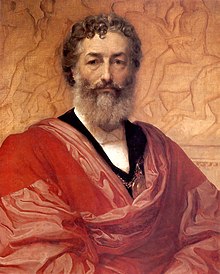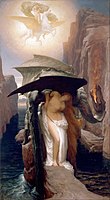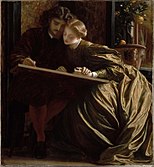Frederic Leighton
The Right Honourable The Lord Leighton PRA | |
|---|---|
 Frederic Leighton, "Self-portrait", 1880 | |
| Born | Frederic Leighton (1830-12-03)3 December 1830 Scarborough, North Riding of Yorkshire, England |
| Died | 25 January 1896(1896-01-25) (aged 65) Kensington, London, England |
| Education | Eduard von Steinle and Giovanni Costa |
| Known for | Painting and sculpture |
Notable work |
Flaming June |
| Movement | Academicism, Neoclassicism and British Aestheticism |
| Awards | Prix de Rome, Légion d'honneur |
Frederic Leighton, 1st Baron Leighton, PRA (3 December 1830 – 25 January 1896), known as Sir Frederic Leighton between 1878 and 1896, was an English painter and sculptor. His works depicted historical, biblical, and classical subject matter. Leighton was bearer of the shortest-lived peerage in history; after only one day his hereditary peerage became extinct upon his death.[1]
Contents
1 Biography
1.1 Honours timeline
2 Selected works
3 Gallery
4 See also
5 Notes
6 References
7 External links
Biography

Flaming June (1895; Museo de Arte de Ponce).

After Vespers (1871; Princeton University Art Museum)
Leighton was born in Scarborough to Augusta Susan and Dr. Frederic Septimus Leighton. He had two sisters including Alexandra who was Robert Browning's biographer.[2] He was educated at University College School, London. He then received his artistic training on the European continent, first from Eduard von Steinle and then from Giovanni Costa. At age 17, in the summer of 1847, he met the philosopher Arthur Schopenhauer in Frankfurt and drew his portrait, in graphite and gouache on paper — the only known full-length study of Schopenhauer done from life.[3] When he was 24 he was in Florence; he studied at the Accademia di Belle Arti, and painted the procession of the Cimabue Madonna through the Borgo Allegri. From 1855 to 1859 he lived in Paris, where he met Ingres, Delacroix, Corot and Millet.
In 1860, he moved to London, where he associated with the Pre-Raphaelites. He designed Elizabeth Barrett Browning's tomb for Robert Browning in the English Cemetery, Florence in 1861. In 1864 he became an associate of the Royal Academy and in 1878 he became its President (1878–96). His 1877 sculpture, Athlete Wrestling with a Python, was considered at its time to inaugurate a renaissance in contemporary British sculpture, referred to as the New Sculpture. American art critic Earl Shinn claimed at the time that "Except Leighton, there is scarce any one capable of putting up a correct frescoed figure in the archway of the Kensington Museum."[4] His paintings represented Britain at the great 1900 Paris Exhibition.
Leighton was knighted at Windsor in 1878,[5] and was created a baronet, of Holland Park Road in the Parish of St Mary Abbots, Kensington, in the County of Middlesex, eight years later.[6] He was the first painter to be given a peerage, in the 1896 New Year Honours. The patent creating him Baron Leighton, of Stretton in the County of Shropshire, was issued on 24 January 1896;[7] Leighton died the next day of angina pectoris.

Sir Frederick Leighton by George Frederic Watts
Leighton remained a bachelor; rumors of him having an illegitimate child with one of his models, in addition to the supposition that Leighton may have been a homosexual, continue to be debated.[8] He certainly enjoyed an intense and romantically tinged relationship with the poet Henry William Greville whom he met in Florence in 1856.[9] The older man showered Leighton in letters, but the romantic affection seems not to have been reciprocated. Enquiry is furthermore hindered by the fact that Leighton left no diaries and his letters are telling in their lack of reference to his personal circumstances. No definite primary evidence has yet come to light that effectively dispels the secrecy that Leighton built up around himself, although it is clear that he did court a circle of younger men around his artistic studio.[8]
After his death his barony was extinguished after existing for only a day; this is a record in the Peerage. His house in Holland Park, London has been turned into a museum, the Leighton House Museum. It contains many of his drawings and paintings, as well as some of his former art collection including works by Old Masters and his contemporaries such as a painting dedicated to Leighton by Sir John Everett Millais. The house also features many of Leighton's inspirations, including his collection of Iznik tiles. Its centrepiece is the magnificent Arab Hall. The Hall is featured in issue ten of Cornucopia.[10]
A blue plaque commemorates Leighton at Leighton House Museum.[11]
Leighton was an enthusiastic volunteer soldier, enrolling with the first group to join the 38th Middlesex (Artists') Rifle Volunteer Corps (later to be known as the Artists Rifles) on 5 October 1860.

Sir Frederick Leighton, later in his career.
His qualities of leadership were immediately identified, and he was promoted to command A Company within a few months. On 6 January 1869 Captain Leighton was elected to command the Artists Rifles by a general meeting of the corps. In the same year he was promoted to major and in 1875 to lieutenant colonel. Leighton resigned as commanding officer in 1883.
The painter James Whistler famously described the then, Sir Frederic Leighton, the commanding officer of the Artists Rifles, as the: “Colonel of the Royal Academy and the President of the Artists Rifles – aye, and he paints a little!"
At his funeral, on 3 February 1896, his coffin was carried into St Paul's Cathedral, past a guard of honour formed by the Artists Rifles.[12]
Honours timeline
- 1864 – Associate of the Royal Academy
- 1868 – Royal Academy Academician
- 1878 – President of the Royal Academy
- 1878 – Légion d'honneur Officer
- 1878 – Knight Bachelor
- 1886 – Created a baronet in the Baronetage of the United Kingdom
- 1889 – Associate member of the Institute of France
- 1896 – Created a baron in the Peerage of the United Kingdom
Selected works

Cimabue's Celebrated Madonna is carried in Procession through the Streets of Florence, 1853–1855

Daphnephoria, oil on canvas painting, 1874–1876, Lady Lever Art Gallery

Athlete Wrestling with a Python 1877
Death of Brunelleschi (1852), oil on canvas
The Fisherman and the Siren, c. 1856–58 (66.3 x 48.7 cm)
Cimabue's Celebrated Madonna is carried in Procession through the Streets of Florence (1853–55),[13] oil on canvas.
The Discovery of Juliet Apparently Lifeless (c.1858)[14]
The Villa Malta, Rome (1860s),[15] oil on canvas
The Painter's Honeymoon, c. 1864 (83.8 x 77.5 cm)
Mother and Child, c. 1865, (48.2 x 82 cm)
Actaea, the Nymph of the Shore (1868),[16] oil on canvas, (57.2 x 102.2 cm) National Gallery of Canada, Ottawa.
Daedalus and Icarus, c. 1869, (138.2 x 106.5 cm)
Hercules Wrestling with Death for the Body of Alcestis (1869–71) (132.4 x 265.4 cm)
After Vespers 1871, (111.5 x 71.5 cm), Princeton University Art Museum
Greek Girls Picking up Pebbles by the Sea, 1871 (84 x 129.5 cm)
Teresina (circa 1874) Christchurch Art Gallery Te Puna o Waiwhetu, Christchurch, New Zealand
Music Lesson, c. 1877, (92.8 x 118.1 cm)
An Athlete Wrestling with a Python (1877),[17] bronze sculpture
Nausicaa, c. 1878 (145 x 67 cm)
Winding the Skein, c. 1878, (100.3 x 161.3 cm)
Light of the Harem, c. 1880, (152.4 x 83.8 cm)
Idyll, c. 1880–81
Wedded, (c. 1881–1882) (145.4 x 81 cm)
Cymon and Iphigenia (1884) Art Gallery of New South Wales
Captive Andromache, c. 1888 (197 x 406.5 cm)
The Bath of Psyche, (c. 1889–90) (189.2 x 62.2 cm) Tate Gallery
The Garden of the Hesperides, c. 1892, (169 x 169 cm)
Flaming June (1895), oil on canvas, Museo de Arte de Ponce, Puerto Rico (120.6 x 120.6 cm)
The Parable of the Wise and Foolish Virgins (Fresco)[18]
- The armlet
Phoebe (55.88 x 60.96 cm)- A Bather
The Leighton Frescoes, The Arts of Industry as Applied to War and The Arts of Industry as Applied to Peace
Phoenicians Trading with the Early Britons on the Coast of Cornwall, 1895. Mural at the Royal Exchange, London
The Return of Perspephone 1891, oil on canvas, Leeds Art Gallery[19]
Gallery

Icarus and Daedalus

The Garden of the Hesperides, oil on canvas painting, 1892, Lady Lever Art Gallery

The Sluggard

Athlete wrestling with a Python, white marble sculpture, 1888–1891 (Private collection: on loan to the Art Gallery of New South Wales)

The Fisherman and the Syren, c.1856–1858, private collection

The Last Watch of Hero

Perseus and Andromeda, 1891, Walker Art Gallery, Liverpool.

Moses views the Promised Land

The Painter's Honeymoon, 1864

Memories, 1883

The Bath of Psyche, 1879

Solitude

Idyll, c. 1880–81

Captive Andromache, oil on canvas painting, 1886–1888, Manchester City Art Gallery

Cymon and Iphigenia, oil on canvas painting, 1884, Art Gallery of New South Wales

Portrait of May Sartoris at about 15 years of age, Kimbell Art Museum, Fort Worth, TX.
See also
 | |
- List of Orientalist artists
- Orientalism
Romola – the novel by George Eliot for which he did the illustrations
Notes
^ Peerage records – Leigh Rayment's Peerage Page
^
Elizabeth Lee, ‘Orr, Alexandra (1828–1903)’, rev. Katharine Chubbuck, Oxford Dictionary of National Biography, Oxford University Press, 2004 accessed 30 April 2017
^ Crowther, Paul, and Miruna Cuzman. "A Rediscovered Contemporary Full-Length Sketch-Portrait of Schopenhauer by Frederic, Lord Leighton." Schopenhauer Jahrbuch, 92 Band, Konigshausen und Neumann, 2011: 301–306.
^ Shinn, Earl (1880). The World's Art: From the International Exhibition. Lovering..mw-parser-output cite.citation{font-style:inherit}.mw-parser-output .citation q{quotes:"""""""'""'"}.mw-parser-output .citation .cs1-lock-free a{background:url("//upload.wikimedia.org/wikipedia/commons/thumb/6/65/Lock-green.svg/9px-Lock-green.svg.png")no-repeat;background-position:right .1em center}.mw-parser-output .citation .cs1-lock-limited a,.mw-parser-output .citation .cs1-lock-registration a{background:url("//upload.wikimedia.org/wikipedia/commons/thumb/d/d6/Lock-gray-alt-2.svg/9px-Lock-gray-alt-2.svg.png")no-repeat;background-position:right .1em center}.mw-parser-output .citation .cs1-lock-subscription a{background:url("//upload.wikimedia.org/wikipedia/commons/thumb/a/aa/Lock-red-alt-2.svg/9px-Lock-red-alt-2.svg.png")no-repeat;background-position:right .1em center}.mw-parser-output .cs1-subscription,.mw-parser-output .cs1-registration{color:#555}.mw-parser-output .cs1-subscription span,.mw-parser-output .cs1-registration span{border-bottom:1px dotted;cursor:help}.mw-parser-output .cs1-ws-icon a{background:url("//upload.wikimedia.org/wikipedia/commons/thumb/4/4c/Wikisource-logo.svg/12px-Wikisource-logo.svg.png")no-repeat;background-position:right .1em center}.mw-parser-output code.cs1-code{color:inherit;background:inherit;border:inherit;padding:inherit}.mw-parser-output .cs1-hidden-error{display:none;font-size:100%}.mw-parser-output .cs1-visible-error{font-size:100%}.mw-parser-output .cs1-maint{display:none;color:#33aa33;margin-left:0.3em}.mw-parser-output .cs1-subscription,.mw-parser-output .cs1-registration,.mw-parser-output .cs1-format{font-size:95%}.mw-parser-output .cs1-kern-left,.mw-parser-output .cs1-kern-wl-left{padding-left:0.2em}.mw-parser-output .cs1-kern-right,.mw-parser-output .cs1-kern-wl-right{padding-right:0.2em}
^ "No. 24651". The London Gazette. 29 November 1878. p. 6695.
^ "No. 25551". The London Gazette. 22 January 1886. p. 328.
^ "No. 26705". The London Gazette. 31 January 1896. p. 587.
^ ab Emanuel Cooper, The Sexual Perspective: Homosexuality and Art in the Last 100 Years in the West, 2005
^ Oxford Dictionary of National Biography vol 33
^ Cornucopia 10, Ingres and Lady Mary Montagu, Leighton House, yurts, the Lycians plus elegant eggplant. Cornucopia.net. Retrieved on 20 February 2011.
^ "LEIGHTON, FREDERICK, LORD LEIGHTON (1830–1896)". English Heritage. Retrieved 1 July 2012.
^ Barry Gregory. A History of The Artists Rifles 1859–1947. Pen & Sword. 2006.
^ Frederic, Lord Leighton | Cimabue's Celebrated Madonna | L275 | The National Gallery, London. Nationalgallery.org.uk. Retrieved on 20 February 2011.
^ Tate Collection | Study for 'The Discovery of Juliet Apparently Lifeless'. Tate.org.uk. Retrieved on 20 February 2011.
^ Frederic, Lord Leighton | The Villa Malta, Rome | L851 | The National Gallery, London. Nationalgallery.org.uk. Retrieved on 20 February 2011.
^ Artwork Page: Actaea, the Nymph of the Shore. Cybermuse.gallery.ca. Retrieved on 20 February 2011.
^ Tate Collection | An Athlete Wrestling with a Python by Frederic, Lord Leighton. Tate.org.uk. Retrieved on 20 February 2011.
^ Newforestparishes.com Archived 3 July 2007 at the Wayback Machine
^ Leeds Art Gallery, listings
References
 This article incorporates text from a publication now in the public domain: Chisholm, Hugh, ed. (1911). . Encyclopædia Britannica. 17 (11th ed.). Cambridge University Press. pp. 396–398.
This article incorporates text from a publication now in the public domain: Chisholm, Hugh, ed. (1911). . Encyclopædia Britannica. 17 (11th ed.). Cambridge University Press. pp. 396–398.
External links
| Wikimedia Commons has media related to Frederic Leighton. |
Frederic-Leighton.org 114 works by Frederic Leighton
Advice to Young Artists by Frederick Lord Leighton high resolution images- Scarborough, Birthplace of Lord Frederic Leighton
- Leighton House Museum
- Obituary from The Times
- Leighton Gallery at MuseumSyndicate
171 paintings by or after Frederic Leighton at the Art UK site
| Cultural offices | ||
|---|---|---|
| Preceded by Sir Francis Grant |
President of the Royal Academy 1878–1896 |
Succeeded by Sir John Everett Millais, Bt |

















Comments
Post a Comment